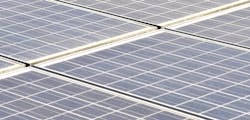Because the roof on a typical school building is flat, that makes it a prime location for the installation of solar panels.
Solar installations enable schools and universities to generate clean energy, reduce their greenhouse gas emissions, and provide opportunities to teach students about sustainability and conservation.
As prices have fallen for solar energy systems, the sight of photovoltaic (PV) panels on the campuses of education institutions have become more commonplace. Sometimes the installations can be found in fields or as shade structures that cover parking lots, but the most likely place for solar arrays at schools is atop buildings.
According to the Solar Foundation, a non-profit organization that advocates for solar energy, 7,332 schools in the United States had installed solar energy systems of their campuses by the end of 2019. More than 5 million students attend schools with a solar installation, an 81% rise between 2014 and 2019.
Often with the help of rebates or other incentives, schools are continuing to add solar panels.
In February, New York City officials announced plans to install rooftop solar arrays at 47 Department of Education buildings in all five boroughs of the city.
City officials say carbon emissions from public schools account for nearly one-third of emissions from the city’s building portfolio. Adding solar to schools provides carbon emissions reduction potential as well as opportunities for students to learn about the importance of sustainability and climate action.
“New solar installations on schools and other public facilities will generate green energy that will help achieve Mayor de Blasio’s goal of reducing citywide emissions 80% by 2050,” says Lisette Camilo, commissioner of the city’s Department of Citywide Administrative Services.
Solar arrays can cut energy bills, tool. Rob Sand, Iowa State Auditor, issued a report in February noting that 80 schools, cities and other public entities in the state had solar energy systems that generated average annual savings of about $26,475.
“If each county, each county seat, and each school district created a solar installation of the average size of these installations, over the installations’ lifetimes, Iowa taxpayers could expect to net over $375 million in savings,” Sand says. “…In one school district, the savings equaled a teaching position. In another, the savings allowed the district to keep the school open and avoid consolidation.”
A March 2019 article in the journal Environmental Research Letters says that the energy-generating potential of installing solar panels on school rooftops is massive.
In “Solar PV as a mitigation strategy for the U.S. education sector,” authors Nichole L. Hanus, Gabrielle Wong-Parodi, Parth T. Vaishnav, Naїm R. Darghouth and Inês L. Azevedo estimate that the United States has more than 132,000 education buildings—public and private, K-12 and higher education. Those facilities have total available rooftop space of 400 million square meters.
“We find that solar PV in US educational institutions could provide 100 [terawatt hours] of electricity services annually, meeting 75% of these buildings' current electricity consumption,” the article states.
School buildings in Texas, California, and Florida have the highest potential for generating solar power.
Educational institutions account for 11% of total U.A. building electricity consumption and contribute about 4% of total US carbon dioxide emissions, “making them a decent target for climate mitigation strategies,” the authors say.
The potential for generating electricity from rooftop solar photovoltaic panels on educational institutions “could reduce health, environmental, and climate change damages by roughly $4 billion per year,” the researchers say.
Installing rooftop solar on school buildings would have the highest health, environmental, and climate change benefits in “regions where it is offsetting carbon-intensive and high-polluting technologies such as coal-fired power plants in the Midwest,” the authors conclude.
However, the authors also state that in most cases, it is not economically viable for educational institutions to purchase these systems outright.
“The private costs of solar for educational institutions still exceed the private benefits from reduced electricity consumption across the entire country (unless a third-party operation model is used),” the article states.
A power purchasing agreement or other third-party owner scenarios that allow schools and universities to divert the capital and annual costs of owning a system may be economically viable.
The authors also suggest that if educational institutions were rewarded for reducing emissions, then it would be feasible for institutions to purchase the systems outright.
“Electricity prices that reflect the cost of emissions is one way to internalize this benefit from PV systems,” the authors assert. “Alternatively, utilities and government agencies could increase rebates.”
Making renewable energy such as solar power a higher priority would encourage schools to look more closely as such systems as an option.
“Policy makers might focus on incentivizing the adoption of solar PV on K-12 public, higher education, and K-12 private institutions…if the goal is to maximize PV generation,” the researchers say.
About the Author
Mike Kennedy
Senior Editor
Mike Kennedy, senior editor, has written for AS&U on a wide range of educational issues since 1999.
